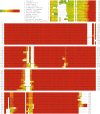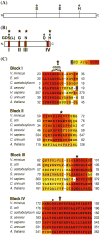The Arabidopsis thaliana ortholog of a purported maize cholinesterase gene encodes a GDSL-lipase
- PMID: 23430565
- PMCID: PMC3769184
- DOI: 10.1007/s11103-013-0021-8
The Arabidopsis thaliana ortholog of a purported maize cholinesterase gene encodes a GDSL-lipase
Abstract
Acetylcholinesterase is an enzyme that is intimately associated with regulation of synaptic transmission in the cholinergic nervous system and in neuromuscular junctions of animals. However the presence of cholinesterase activity has been described also in non-metazoan organisms such as slime molds, fungi and plants. More recently, a gene purportedly encoding for acetylcholinesterase was cloned from maize. We have cloned the Arabidopsis thaliana homolog of the Zea mays gene, At3g26430, and studied its biochemical properties. Our results indicate that the protein encoded by the gene exhibited lipase activity with preference to long chain substrates but did not hydrolyze choline esters. The At3g26430 protein belongs to the SGNH clan of serine hydrolases, and more specifically to the GDS(L) lipase family.
Figures








References
-
- Baudouin E, Charpenteau M, Roby D, Marco Y, Ranjeva R, Ranty B. Functional expression of a tobacco gene related to the serine hydrolase family—esterase activity towards short-chain dinitrophenyl acylesters. Eur J Biochem. 1997;248(3):700–706. - PubMed
-
- Becker D, Kemper E, Schell J, Masterson R. New plant binary vectors with selectable markers located proximal to the left T-DNA border. Plant Mol Biol. 1992;20(6):1195–1197. - PubMed
Publication types
MeSH terms
Substances
Grants and funding
LinkOut - more resources
Full Text Sources
Other Literature Sources
Molecular Biology Databases

